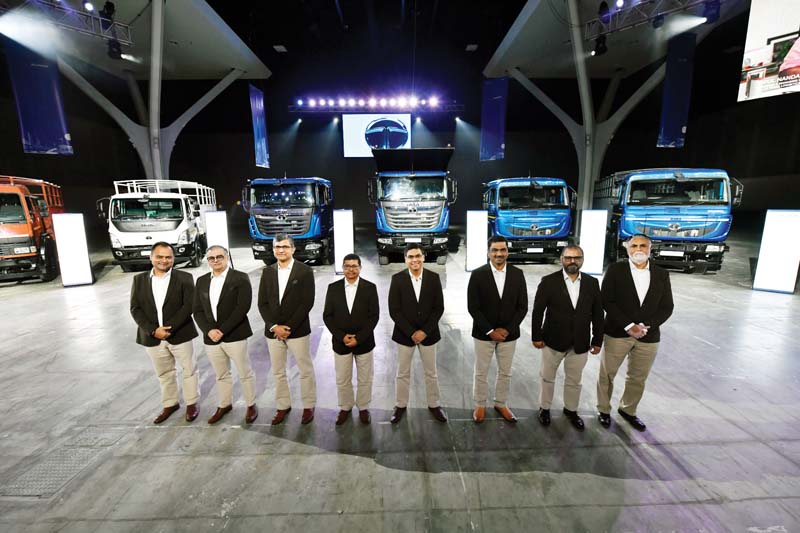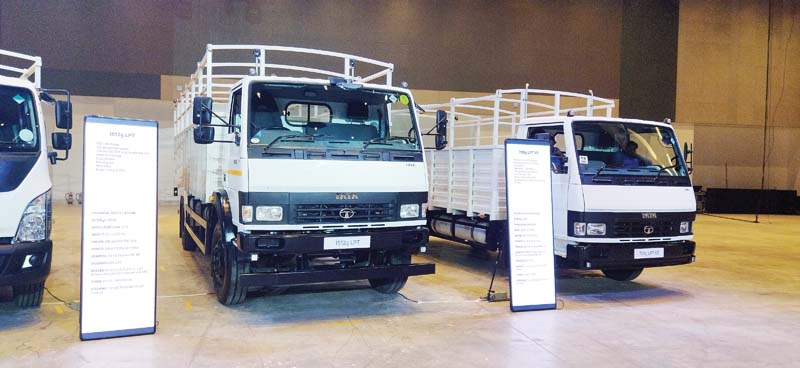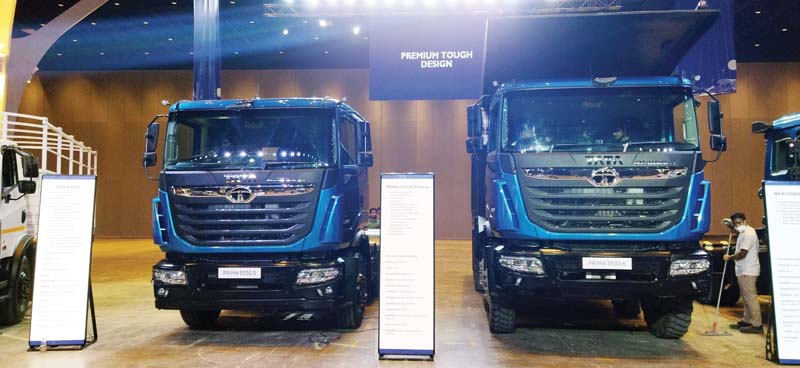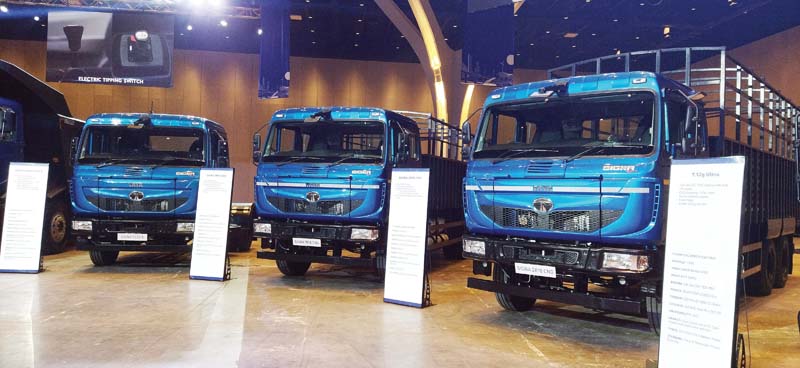The recent string of upgrades and launches has Tata Motors catering to a broader customer base. Ashish Bhatia looks at the emerging road map with the potential to change the paradigm of first and last-mile transportation.
Tata Motors has had a spate of new launches in recent quarters. This trend is well expected to continue into the business end of the fiscal. The company, simply put, has re-looked every segment with its 0.5-tonne to 55-tonne offerings, from pickup trucks to the Medium and Heavy Commercial Vehicles (M&HCVs) higher in the spectrum. It is with an intent to offer the customers and internal stakeholders a higher Return on Investment (RoI) that the company is offering technological upgrades, more capable legacy models, and a 10 per cent reduction of Total Cost of Ownership (TCO) backed by an enhanced aftermarket suite. Sharing the objective behind the string of new launches, which include the range of 14 ‘Smart Trucks’ followed by four new pickup trucks, in quick succession, Girish Wagh, Executive Director at Tata Motors Ltd. averred, “The new range of products align with the customers’ need for technological upgrades including the adaption to alternative drive trains like the first 19-tonne and 28-tonne M&HCVs on CNG; the first bi-fuel (CNG + Petrol) SCV pickup in the one-tonne range; L1 autonomy for HCV. Through the new range, the focus has been on offering distinct advantages to the operator like the highest power-to-weight ratio for a quicker Turn Around Time (TAT), highest loading capacity, off-road capabilities, safety compliance and best-in-class comfort against the backdrop of the growing infrastructure in the country.”

Wagh reiterated that the new product and service offerings will therefore change the paradigm of first and last-mile transportation. Taking forward the ambition to create an aspirational pool of CVs, he said, the recent launch was a big step in the right direction. He also hinted at additional projects being in the pipeline that could be expected to further raise the bar. The Original Equipment Manufacturer (OEM), in October 2022, a little after the launches touched upon above, was able to register a total sales of 32,912 CVs in October 2022, at a marginal two per cent dip against the same period last year (October 2021) when the company sold 33,674 vehicles. The dip here can be attributed to the International Business (IB) that de grew 35 per cent in October 2022 (1592 units) compared to October 2021 when the company sold 2,448 units. In the domestic market, the company saw sales plateauing at 31,320 units which were accounted for by 9,860 units of HCVs at a 29 per cent growth rate; 4,083 I&LCVs at a 27 per cent de growth; 1,759 passenger carriers signalling a V-shaped recovery at 84 per cent growth rate and an eight per cent degrowth in SCV and pickups selling 15,618 units. Notably, the company has also informed of a planned shutdown at the Pune plant, for preventive maintenance and de bottle necking actions leading to an overall lower production in October 2022. It is confident of the launches having a positive baring on the quarters ahead.
WIDEST Pickup RANGE
The company has piqued customer interest with the launch of the new Tata Yodha 2.0 as the first two-tonne pickup truck (read on the ‘Road Check’ featured in this issue) and the Tata Intra V50 with the highest power-to-weight ratio for the segment and a rated payload capacity of 1.5-tonne (Watch out for ‘Road Check’ coming up in the upcoming issue of CV). Explaining the objective behind the upgrades undertaken for the SCV pickup range, Vinay Pathak, Vice President, Product Line – SCV&PU, Tata Motors stated, “The customer requirements are changing very rapidly. We have co-created these products with the customers by working closely with them and therefore we are confident of meeting most of the requirements of the customers like is the case with the pickup segment.” On the aspiration to own pickups in India in comparison to the advanced economies, he gave an example of the foreign markets bifurcated into those dominated by the traditional pickups and the others moving up the ladder to SCV-based pickup solutions which is the case with Brazil and China.
In India, looking to introduce efficiencies to the logistics sector, particularly with the cost of logistics known to be high in the country, Tata Motors is betting big on the direction that is in favour of more efficient and capable solutions. Looking to leverage the sweet spot, which translates to lower TCO, even on new platforms where economies of scale may be lacking initially, the company is hoping to benefit from the momentum gained from a head start. With this segment of customers heavily dependent on vehicle finance schemes (~99 per cent), the company is also working on a digital platform capable of integrating a support structure for its customers. The company is looking to empower these customers that may be high-risk customers owing to unemployment, by roping them into the logistics sector. This, it is expected, will help to create a push for its new range of SCV-based pickups and the traditional pickup known to have evolved to its current generation backed by the latest manufacturing technology. The scenario with pick-ups could help unearth findings vital for the higher segments.
Aniruddha Kulkarni, Vice President, of Engineering, Commercial Vehicle Business, at Tata Motors gave a sneak peek into a mammoth exercise undertaken over months leading up to the new product launches this fiscal year. The company has banked on engineering a modular platform for future compliances and derivatives that could be rolled out from the parent platform. “The effort was undertaken with the thought process of covering aggregate aspects like electronics, architecture, steering, suspension system, and or braking,” he claimed. Going beyond regulations, forming the safety margins including structural integrity, opined Kulkarni, the products are geared to meet the use and abuse cases across duty cycles. This includes looking at the evolution of aggregates that are dependent on the duty cycle using the modular approach where parts commonality and the use of next-generation materials are equally important. Parts independent of the duty cycle like steering wheel, lamps and bumpers are carried forward as is the practice. The modularisation extends to the fuel system also which is optimally packaged and offered in various permutations and combinations. In the case of its bi-fuel vehicle, for instance, the vehicle is equipped with intelligence to switch over from CNG to petrol in case of low-pressure detection, as one of its USP.
Upgraded I&LCVs
Clubbed under the smarter, safer and more efficient range of trucks at the end of the second quarter of FY22 (Q2-FY22), the Intermediate and Light Commercial Vehicles (I&LCV) range had the company launch seven models including the tippers to service the evolving multi- application needs aiming at the logistics and infrastructure sectors. Building on, the company is looking at offering higher productivity and low TCO to drive up fleet operator profitability. The segment backed by fleet management suite ‘Fleet Edge’ and ‘Sampoorna Seva’ , a care package that extends to insurance or breakdown, rewards or genuine Spares, resale or warranty, has the company enhancing customer experience at every touch point. Notably, fully built options of load bodies, tippers, tankers, bulkers and trailers are expected to help the OEM gain ground with customers across segments like agriculture, cement, iron & steel, container, vehicle carrier, petroleum, chemical, water tankers, LPG, FMCG, white goods, perishables, construction, mining, and municipal applications to name a few use cases.
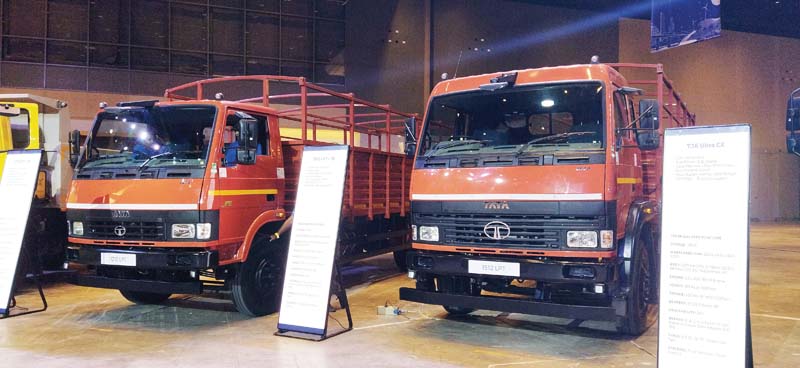
The company has brought out vehicles with multiple cabins and engine options to suit the profile of the vehicle as per the intended duty cycle it would be subjected to. Positioned as the Fuel Efficient (FE) series, it includes optimised drivelines, low viscous rear axle oil, e-viscous radiator fan, gearshift advisor and low rolling resistance tyres on the models. The LPK 610 boasts of high ground clearance and H2LS brakes that the company claims offer effective braking with a short stopping distance. The LPT 709g XD features a five sq. ft. deck area and is claimed to offer up to 10 per cent higher fuel efficiency. The SK 710 tipper brings along a four cubic metre body on the company’s SFC platform. The Ultra T.12g has been introduced with the 3.8-litre SGI turbocharged engine. The Ultra K.14 is claimed to offer best in class comfort, and an air-conditioned cabin with a best-in-class, grade-ability of 37 per cent. The LPT 1512g claims to enhance fuel efficiency by 10 per cent. It also offers the highest CNG storage capacity. The Ultra T.16 Cx powered by a 3.3-litre engine offers the high on comfort Ultra cabin.
Upgraded M&HCVs
In the M&HCVs segment, the company introduced five CNG models and was hailed for the launch of the segment’s first CNG truck for 19-tonne GVW on a multi-axle truck with a maximum range of up to 1,000 kms on the modular architecture. While the former (19-tonne) is offered with deck length options of 20 ft. and 32 ft., the latter (28-tonne) is offered with the 24 ft. and 32 ft. load decks. A testimony to the company looking at advancing technology, it drives in the L1 Advanced Driver Assistance System (ADAS) – Collision Mitigation System, Lane Departure Warning System and Driver Monitoring System for its HCV range. These are offered in the Prima range with extensive validation especially suited for Indian operating conditions where the company has also included features like Electronic Stability Control (ESC) and Tyre Pressure Monitoring System (TPMS). To cater to long-haul operators, the Prima cabin is claimed to be more ergonomically designed. The company claims, the enhancements will have a significant impact in terms of reducing accidents and facilitating safer cargo movement. Other feature additions to the Prima and Signa range include a three-spoke steering wheel with mounted controls and Bluetooth connectivity, a seven-inch advanced HMI touchscreen integrated with advanced connectivity features an all-new instrument cluster and an easy-to-access switch panel.
Rudrarup Maitra, Vice President, Product Line, I&LCV, Tata Motors hailed the introduction of the products like the first Ultra 14-tonne tipper and the full range of tipper bodies. Confirming that the expansion entailed a 10-15 per cent rolling investment plan of the total pie, he opined that the next 12 years would witness many disruptions in the CV sector and the company is geared to play its part. A significant sum, for instance, has also been set aside for R&D activities heading up to the phase two of BSVI in April 2023. With the industry at an inflection point, the emerging road map could have a lasting impact on the progress in the next three to five years. Maitra informed of the need to upskill manpower in mechatronics courtesy a 35 per cent expansion of Tata Motors’ dealer footprint that saw the company add an estimated 135 new dealerships. V Seethapathi, Vice President, Product Line – M&HCV, Tata Motors cited the future and pinned his hopes on the Hydrogen ICE vehicles. Rajesh Kaul, Vice President, Sales & Marketing, CVBU, Tata Motors hailed the achievements of the company and signed off calling it a momentous occasion that had set up the company for the future!



